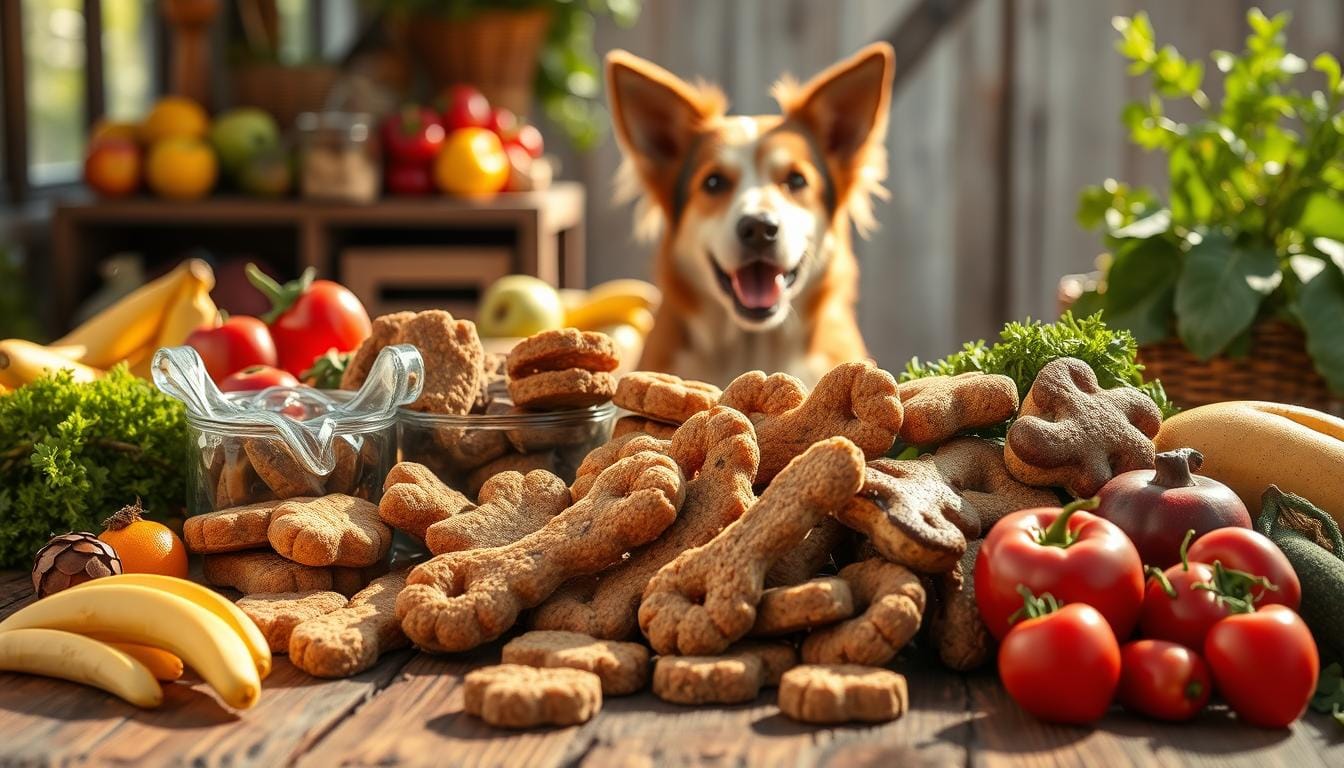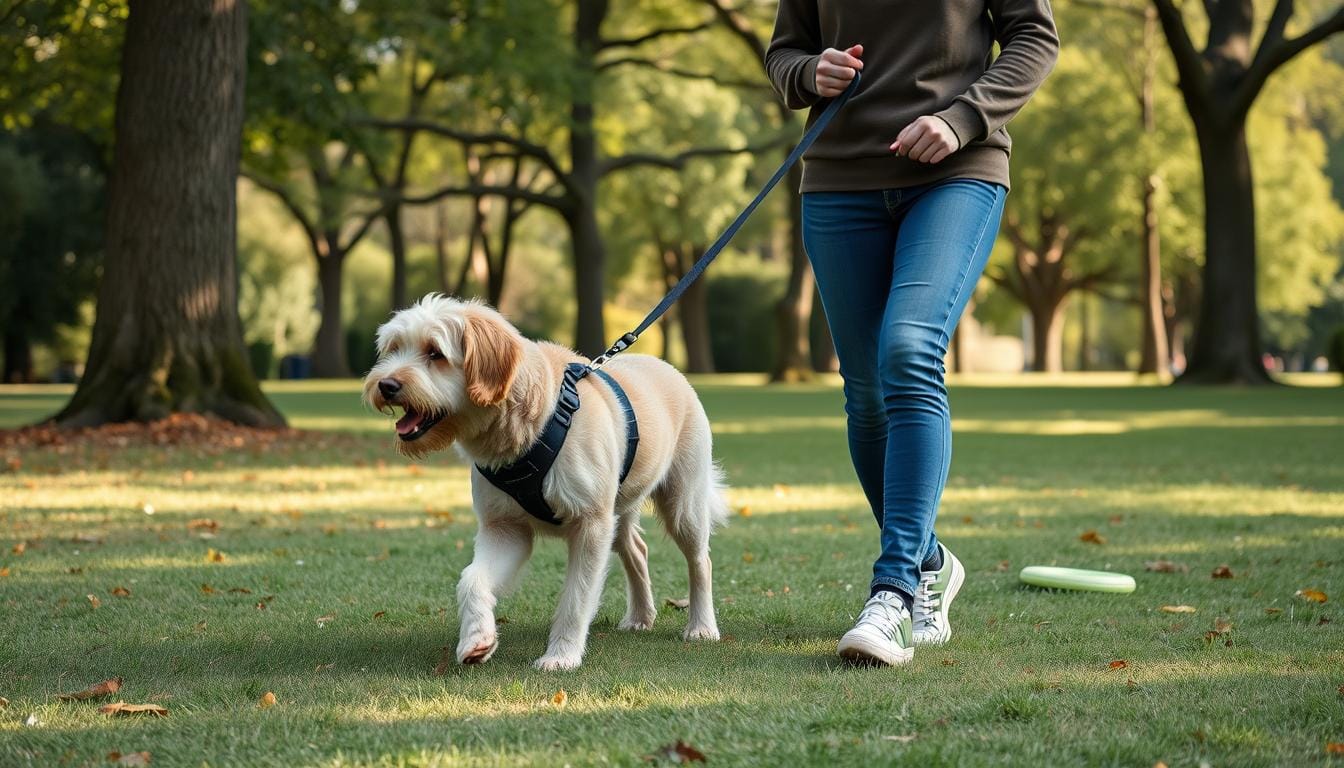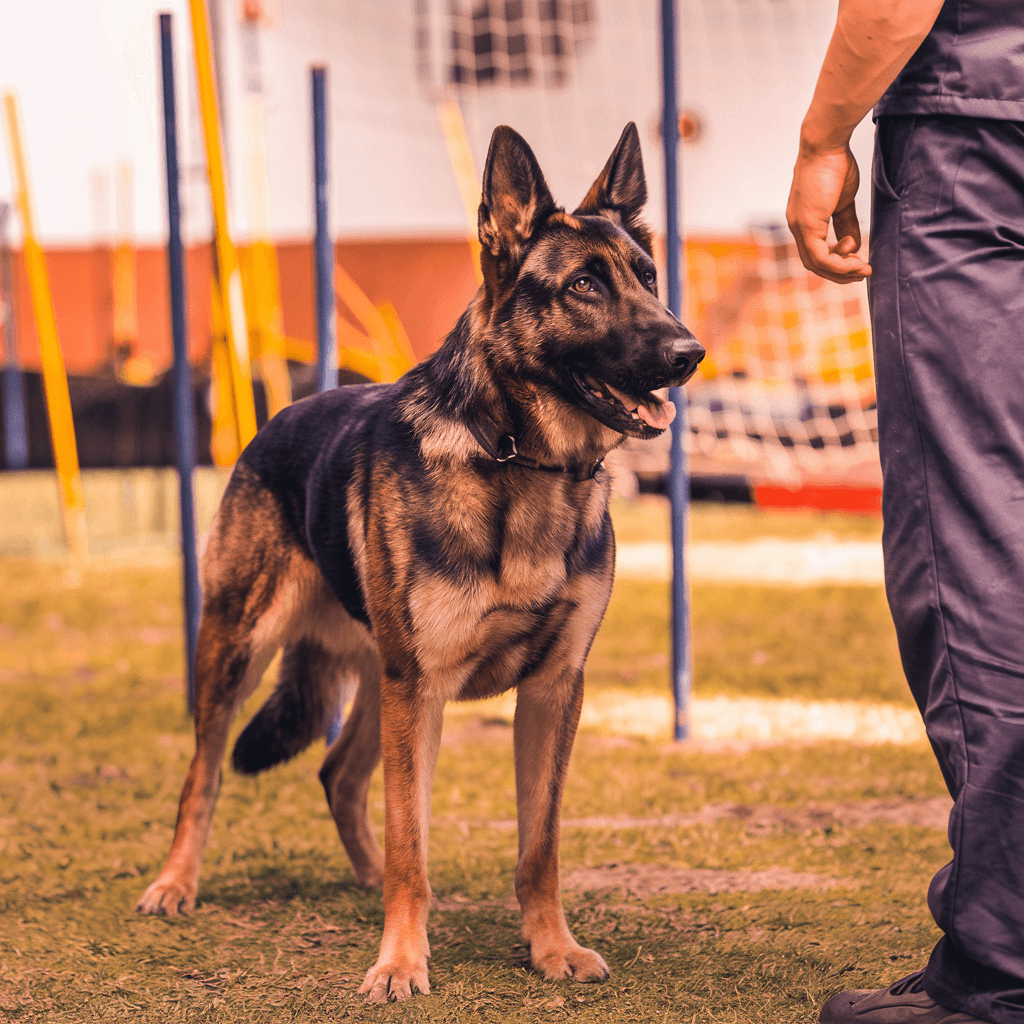Dogs can sense human emotions instinctively. They can read our facial expressions and body language. They even sense changes in our scent. This emotional intelligence is the base of our bond with them, making them great for training and everyday life.
Choosing the right dog treats is key for training. Healthy treats reward good behavior and boost your pet’s health. Let’s explore the world of training treats and find the best ones for your dog.
Finding the perfect training treats means balancing nutrition, taste, and convenience. We’ll look at different types of treats, from soft to crunchy. We’ll also talk about treat size, nutritional value, and using treats in training.
Ready to learn how to train your dog with the right treats? Let’s start this journey together. We’ll strengthen your bond with your dog through positive reinforcement and tasty rewards!
Key Takeaways
- Choose small, low-calorie treats for frequent rewarding during training sessions
- Opt for natural ingredients to avoid harmful additives and allergens
- Consider your dog’s size, age, and dietary needs when selecting treats
- Vary treat types to maintain enthusiasm and prevent boredom
- Use high-value treats for challenging tasks or behavior modification
- Limit treats to 10% of your dog’s daily caloric intake
- Supervise your dog when giving chew treats to prevent choking hazards
Understanding the Importance of Treats in Dog Training
Dog treats are key in training our furry friends. They help us teach good behavior and keep our dogs excited to learn. Let’s see why treats are so important and how to use them right.
The Role of Positive Reinforcement
Positive reinforcement is at the heart of modern dog training. By giving treats for good behavior, we teach our dogs to do it again. This method makes training fun for both dogs and their owners.
How Treats Motivate and Shape Behavior
Treats are strong motivators in dog training. They make learning a positive thing, helping dogs focus and learn faster. Used right, treats help dogs pick up new skills quickly and happily.
- High-value treats work best for teaching new behaviors
- Medium-value treats maintain learned behaviors
- Low-value treats help in generalizing cues
Balancing Treats with Regular Diet
While treats are great for training, we must balance them with our dog’s regular food. Too many treats can make our dogs overweight. Use small, low-calorie treats or eat less on training days. The goal is to reward good behavior, not to fill their bellies.
“The key to successful dog training lies in finding the right balance between treats and praise, ensuring your dog stays motivated without overindulging.”
Understanding the role of treats in dog training helps us create a positive learning experience. With the right use, treats are a powerful tool for raising well-behaved, happy dogs.
Types of Dog Treats for Training
Choosing the right treats is key for dog training. We’ll look at different options to find the best for your pet.
Soft vs. Crunchy Treats
Soft dog treats are a top pick for training. They’re fast to eat, which means more chances to practice in a short time. This quick feedback is vital for learning.

Freeze-Dried and Dehydrated Options
Freeze-dried treats are a favorite for training. They’re light, easy to take along, and full of taste. Many trainers suggest freeze-dried liver or jerky in small pieces for quick training.
Homemade vs. Commercial Treats
Commercial treats are convenient and come in many flavors. Favorites include Vital Essentials Freeze-Dried Minnows and Zuke’s Mini Naturals. Homemade treats let you choose what goes in them but take more time to make.
| Treat Type | Pros | Cons |
|---|---|---|
| Soft Treats | Quick to eat, high reinforcement rate | May be messy |
| Crunchy Treats | Good for dental health | Slow down training |
| Freeze-Dried Treats | Lightweight, flavorful | Can be expensive |
| Homemade Treats | Ingredient control | Time-consuming to prepare |
It’s smart to mix up your treats to keep training fun for your dog. A blend of soft, crunchy, and freeze-dried treats keeps things interesting and prevents boredom.
Nutritional Considerations for Training Treats
When picking healthy dog treats for training, think about their nutritional value. We want to reward our pets without harming their health. Here are some important things to remember when choosing treats for training.
Treats should not be more than 10% of your dog’s daily calories. For example, if your dog needs 400 calories, treats should only be 40 calories. Too many treats can cause obesity and health problems, especially in less active dogs.
When looking for treats, choose ones with real meat as the main ingredient. These offer high-quality protein that dogs enjoy. Stay away from treats with too much fat or artificial stuff. Instead, pick treats with vitamins, minerals, and omega-3 fatty acids for extra health benefits.
Calorie Content of Common Dog Treats
| Treat Type | Average Calories | Benefits |
|---|---|---|
| Dental Chews | 50-100 | Promotes dental health |
| Freeze-Dried Meat | 20-30 | High protein, low fat |
| Baked Biscuits | 30-40 | Crunchy texture for teeth |
| Veggie Treats | 5-10 | Low calorie, high fiber |
If your dog has special dietary needs or allergies, talk to a vet before trying new treats. Remember, it’s all about balance when treating our dogs during training.
Size Matters: Choosing the Right Treat Size for Training
The size of treats is key in dog training. It affects how well they work and your dog’s health. We’ll look at how to pick the best treat size for your furry friend.
Small Treats for Frequent Rewarding
Small dog treats are perfect for training. They let you reward your pup often without overfeeding. Pea-sized treats are great for any size dog, allowing for more training.
Remember, treats should be less than 10% of your dog’s daily calories.

Adjusting Treat Size Based on Dog Breed
The right treat size for training depends on your dog’s breed. Chihuahuas and Maltese need tiny treats, while Labradors can handle bigger ones. Beagles fall in the middle, needing treats that are tasty but also nutritious.
No matter the breed, think about your dog’s needs and energy level.
Breaking Larger Treats into Smaller Pieces
Don’t worry if you have big treats. You can break them into smaller pieces. This is good for big dogs and helps control calories. It also makes expensive treats last longer during training.
Choosing the right treat size keeps your dog motivated and healthy. Always talk to your vet for diet advice that fits your dog’s needs.
High-Value vs. Low-Value Treats: When to Use Each
Knowing the difference between high-value and low-value dog treats is key for good training. High-value treats are more exciting and motivating for dogs. Low-value treats are for everyday rewards. We’ll look at when to use each to improve your training.
High-value treats are moist, smell good, and new to your dog. They’re great for teaching new tricks, training in busy places, or changing bad habits. Examples include small chicken pieces, cheese, or freeze-dried liver.
Low-value treats are dry and crunchy. They’re best for keeping up good habits and slowly stopping treats. Kibble, fruit pieces, and regular dog biscuits are good examples.
| Treat Type | Examples | Best Used For |
|---|---|---|
| High-Value | Sausages, freeze-dried meat, cheese | New behaviors, distractions, behavior modification |
| Low-Value | Dried dog food, vegetable chunks, dog biscuits | Maintaining learned behaviors, everyday reinforcement |
To keep your dog interested, change up your treat plan. Using only high-value treats can get old fast. Mix different treats to keep your dog excited during training. Also, remember treats should be less than 10% of your dog’s daily calories to avoid weight gain and health issues.
Dog Treats: Tailoring Choices to Training Scenarios
Choosing the right treats for your dog’s training is key to success. We’ll look at how to pick treats for different training needs. This ensures your dog stays motivated and focused.
Basic Obedience Training Treats
For basic obedience, medium-value treats are best. Zuke’s Mini Naturals are a top pick, priced between $6 and $20. They’re small, great for rewarding often without overfeeding.
Treats for Agility and Advanced Training
Agility training treats must be high-value to keep dogs motivated. Professional handlers use these treats for their effectiveness. Merrick Power Bites, priced from $8 to $30, are excellent for agility training. They offer energy and flavor.
Treats for Behavior Modification
Behavior modification needs the highest-value treats to create positive associations. Chippin Training Bites, priced around $14, are a great choice. They’re nutritious and enticing, perfect for addressing issues like leash reactivity or anxiety.
Remember, treats should not make up more than 10% of your dog’s diet. It’s important to choose options that balance nutrition and appeal. Here’s a comparison of popular training treats:
| Treat Name | Price Range | Best For |
|---|---|---|
| Zuke’s Mini Naturals | $6 – $20 | Basic Obedience |
| Merrick Power Bites | $8 – $30 | Agility Training |
| Chippin Training Bites | Around $14 | Behavior Modification |
| Fruitables Skinny Minis | Varies | Repetitive Training Tasks |
By tailoring your treat choices to specific training scenarios, you’ll maximize your dog’s learning potential. You’ll also strengthen your bond through positive reinforcement.
Allergies and Sensitivities: Selecting Safe Training Treats
Choosing the right treats for dogs with allergies or sensitivities is key. Around a dog’s first birthday, food sensitivities and skin reactions may start. Common allergens include wheat, corn, soybeans, dairy, and eggs.
For hypoallergenic dog treats, look for those with few ingredients and new protein sources. Venison, duck, and salmon are good choices because they’re less likely to cause allergies. For sensitive stomachs, single-ingredient treats are gentler.
Signs of food allergies in dogs include scratching, stomach issues, skin problems, and ear infections. If you see these signs, it’s time to change your dog’s treats.
- Opt for grain-free products with natural ingredients
- Avoid artificial colors, flavors, and preservatives
- Choose treats with single protein sources
- Consider homemade hypoallergenic treats for complete control over ingredients
Treats should not make up more than 10% of your dog’s daily calories. Always talk to a vet before trying new treats, especially for dogs with allergies. With the right choice, you can find tasty, safe treats for training that keep your dog healthy and happy.
Top Recommended Healthy Dog Treats for Training
Choosing the right treats is key for training our dogs. We’ve found some great options that are tasty and healthy for your pup.
Natural and Organic Options
Natural dog treats are perfect for pet owners who care about health. Zuke’s Mini Naturals have just 3 calories per treat. They’re great for rewarding your dog often during training.
Old Mother Hubbard Classic Crunchy Treats are a great organic choice. They’re made with natural ingredients and are good for your dog’s taste buds and health.
Low-Calorie Training Treats
Low-calorie treats are good for keeping your dog’s weight in check during training. Hill’s Natural Baked Light Biscuits are crunchy but low in calories. Fruitables Skinny Minis also have just 3 calories per treat.
Veterinarian-Approved Choices
Vets often suggest treats that are good for both taste and health. Greenies dental treats reward your dog while keeping their teeth clean. Merrick Power Bites are also vet-approved, packed with protein and good for dogs of all ages.
| Treat Name | Calories per Treat | Price Range |
|---|---|---|
| Zuke’s Mini Naturals | 3 | $4.98 – $19.00 |
| Fruitables Skinny Minis | 3 | $4.98 – $19.00 |
| Wet Noses Little Stars | 1 | $4.98 – $19.00 |
| Pupford Freeze-Dried Training Treats | 1 | $4.98 – $19.00 |
| Vital Essentials Freeze-Dried Raw Dog Treats | 1 | $4.98 – $19.00 |
DIY Healthy Dog Treats for Training
Making your own dog treats for training lets you control what goes into them. It can also save you money. We’ve created a recipe that makes about 1,000 treats in just an hour. These treats are small, soft, and low in calories, perfect for rewarding your dog often without overfeeding.
Our favorite recipe includes canned pumpkin, peanut butter, flour, and egg. You can also add banana or chicken broth for different flavors. Each treat has only 1 calorie, making them great for long training sessions. We use a whole jar in a week, showing how well they work in regular training.
| Recipe Details | Nutritional Info (per treat) |
|---|---|
| Prep Time: 15 minutes | Calories: 53kcal |
| Cook Time: 1 hour | Carbs: 9g |
| Total Time: 1 hour 15 minutes | Protein: 2g |
| Yield: 28 treats (varies with cutter size) | Fat: 1g |
| Rating: 4.92/5 (61 votes) | Fiber: 2g |
Always introduce new treats slowly and in small amounts to avoid stomach problems. With these homemade treats, you’ll have a healthy and affordable way to reward your dog during training.
Avoiding Common Mistakes When Choosing Training Treats
Training our furry friends can be rewarding. But, it’s key to avoid common dog treat mistakes. Let’s look at areas where pet owners often go wrong and how to make better choices for our dogs.
Overfeeding and Calorie Control
Calorie control is vital during training. Giving too many treats can cause weight gain and nutritional problems, especially in puppies. Use small, low-calorie treats and watch portion sizes. Treats should not make up more than 10% of your dog’s daily calories.
Ignoring Ingredient Labels
Reading ingredient labels is crucial when picking treats. Choose healthy, natural options with few ingredients to avoid health and dental issues. Be careful of treats with harmful additives or allergens that could harm your dog.
Using Human Food as Treats
While some human foods are safe for dogs, many are not. Avoid high-fat foods like bacon or sausage as treats. Using table scraps can cause nutritional imbalances and encourage begging. Always use treats made for dogs to keep them safe and balanced.
| Common Mistake | Potential Consequence | Better Alternative |
|---|---|---|
| Overfeeding treats | Weight gain, nutritional imbalances | Use small, low-calorie treats |
| Ignoring ingredient labels | Health issues, allergic reactions | Choose natural treats with minimal ingredients |
| Using human food as treats | Digestive problems, begging behavior | Select dog-specific training treats |
By avoiding these mistakes and choosing the right treats, we can train our dogs effectively. This keeps them healthy and happy.
Conclusion
Choosing the right dog training treats is key for effective training. We’ve looked at what makes a good treat, from nutrition to texture. Treats should only be 10% of your dog’s daily calories, balancing reward and health.
Look for treats with real meats like chicken or beef. Also, consider ones with veggies and fruits for extra nutrients. Stay away from artificial stuff that can cause allergies. Brands like Spencer’s Plate and Piggyback Treats use top-notch ingredients.
Good dog training needs the right treats. Soft treats are liked by 56% of owners because they taste great. Meat snacks are the top choice overall. Choose treats that fit your dog’s likes and training needs, using better treats for harder tasks and simpler ones for everyday practice.
In short, the right treats can really help your dog learn. Focus on your pet’s health and pick treats wisely. This way, you’ll find the best treats for your furry friend.
















